Is this the perfect budget fast prime for Alpha 7 users?
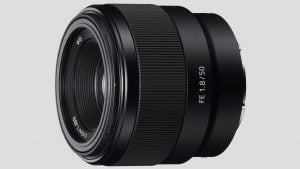
What is the Sony FE 50mm f/1.8?
It’s no secret that the Alpha 7 series of full-frame compact system cameras (CSC) has been a runaway success for Sony. By providing excellent image quality in a package that’s smaller and more portable than any comparable full-frame DSLR, it has become one of the most popular of the new breed of mirrorless systems.
Its importance to Sony is best illustrated by the contrast between the company’s rapid expansion of the new, full-frame FE lens range over the past two years, and the relative stagnation of both the APS-C E-mount and legacy Alpha-mount systems.
One of Sony’s recent additions to its full-frame line-up is the FE 50mm f/1.8. At just £239, it’s the firm’s most affordable FE optic by some way. The focal length will be instantly familiar to generations of film users; for many years 50mm f/1.8 lenses were supplied with 35mm SLRs as standard. Traditionally, they offer a combination of excellent image quality and a usefully large maximum aperture for low-light shooting, while being more compact and less expensive compared with their f/1.4 cousins.
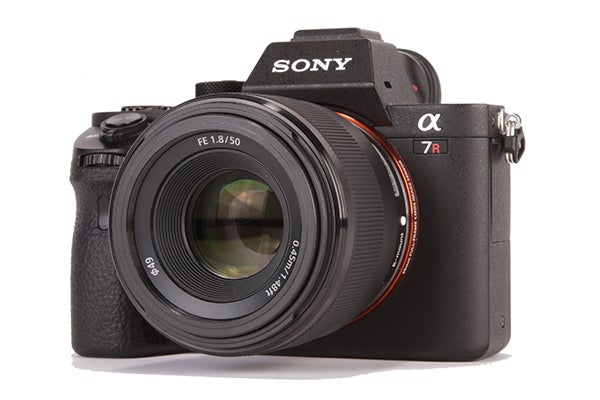 The FE 50mm f/1.8, paired with a Sony A7R
The FE 50mm f/1.8, paired with a Sony A7R
It’s often claimed that 50mm lenses give a field of view similar to the human eye, although given the extent of our peripheral vision this is an oversimplification. But it is true to say that lenses around the 40-50mm bracket tend to bring a very natural perspective to images, imposing neither the wideangle distortion of shorter focal lengths, nor the compression effects typical of telephotos. Because of these qualities, they’ve gained the label ‘normal’.
However, technology has moved on since we were shooting film and focusing manually. In these days of high-quality zooms, in-body image stabilisation and ISO capabilities beyond the dreams of film users, the attractions of the 50mm prime lens are less clear. So does the FE 50mm f/1.8 still warrant a place in the Alpha 7 user’s kit bag?
Sony FE 50mm f/1.8 – Features
Even at a cursory glance, the FE 50mm f/1.8 is unusually sized for this type of lens. However, a look inside its 60mm-long barrel reveals why: there’s a lot of empty space between the mount and the rear element. In essence, Sony has made an adapted version of an SLR lens, starting with the classic double Gauss optical design that most fast 50mm primes have traditionally been based upon, then adding an adapter tube to place it the right distance from the sensor.
 The large aperture allows selective focusing with shallow depth of field
The large aperture allows selective focusing with shallow depth of field
It’s not quite that simple, though, because while the six-element, five-group optical formula sounds fairly standard, Sony has employed an aspheric element at the back, which is much less common. In principle, this should go a long way to eliminating spherical aberration, which tends to be a problem with fast primes, robbing images of their sharpness at large apertures. It’s also claimed to reduce aberrations such as coma towards the edges of the frame.
The aperture diaphragm consists of seven curved blades that are designed to maintain a near-circular opening at wider settings for more attractive blur characteristics. Up front there’s a non-rotating 49mm filter thread and a bayonet mount for the attachment of the included cylindrical ALC-SH146 hood.
The lens can be used on Sony’s E-mount APS-C cameras such as the Alpha 6300, on which it gives a 75mm equivalent angle of view popular for people pictures. However, unlike Sony’s existing APS-C-dedicated E 50mm f/1.8 OSS, there’s no optical stabilisation, which makes the FE lens a less practical option for users of the smaller format. Of course, users of second-generation Alpha 7 models will benefit from in-body image stabilisation.
Sony FE 50mm f/1.8 – Build and handling
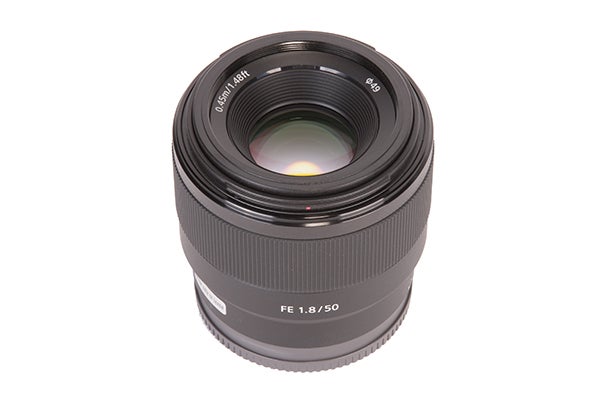
Weighing just 186g, the FE 50mm f/1.8 is distinctly lightweight as full-frame lenses go, thanks to its predominantly plastic barrel construction. The finely ridged manual-focus ring has a hard plastic covering, while in a reassuring touch, the mount is metal. The lens is smaller than any of Sony’s FE zooms, and when used on an Alpha 7 body it makes for a fairly compact, discreet set-up. However, it’s not as small as Sony’s FE 35mm f/2.8 and FE 28mm f/2 primes, which use optics designed for the short flange distance of the E-mount.
Sony FE 50mm f/1.8 – Focusing
One characteristic of the FE 50mm f/1.8 that has carried over from traditional manual-focus SLR lenses relates to focusing. Unlike more modern designs, which overwhelmingly employ high-speed internal focusing, the FE 50mm f/1.8 works by racking the entire optical unit back and forwards instead. Indeed, at its minimum focus distance of 0.45m, the front of the lens extends almost 1cm forward from its infinity position. This approach isn’t a problem for manual focusing, but turns out to be far from ideal for autofocus.
Indeed, when it comes to AF, this is probably the least satisfactory lens I’ve used for many a year. Even when used on the Alpha 7R II with its much-lauded on-chip phase-detection, autofocus is slow and often feels uncertain. The lens tends to noticeably overshoot the mark and readjust back to correct focus – behaviour that’s much more typical of a contrast-detection system. Because the focus motor has to move lots of glass around this isn’t a quick process, and I often found that I was held up for a second or two waiting for the lens to achieve focus. Video shooters will also find that the whirring of the DC motor is audible on their soundtrack.
 The 50mm focal length is ideal for street photography, but the lens’s slow focusing can be a problem if events change quickly
The 50mm focal length is ideal for street photography, but the lens’s slow focusing can be a problem if events change quickly
With static subjects this sluggishness isn’t too detrimental to the picture-taking process, although it is rather irritating. Fortunately, focus accuracy is consistently high, just so long as you place the AF area on a reasonably high-contrast target. But when faced with trying to get a quick shot, it all-too-frequently fails to react in time. To provide some context, Canon’s recent EF 50mm f/1.8 STM also uses a unit-focus, double Gauss design but is noticeably quieter and quicker.
You can, of course, focus manually, using the broad, smoothly rotating ring on the barrel. This employs a focus-by-wire mechanism that instructs the lens’s internal motor to move the optical unit. Like most such systems, it allows very accurate focusing when used in concert with the camera’s focus aids, such as magnified and peaking views. But it’s not especially intuitive – for example, there’s no change in resistance when the focus reaches the end of its travel. To be fair, this is commonplace with CSC lenses, and you’ll only get more tactile manual focusing from rather pricier designs.
Sony FE 50mm f/1.8 – Image quality
The FE 50mm f/1.8’s focusing may be disappointing, but its optical quality is quite the opposite. Indeed, the images it creates are generally excellent given its price. Wide open, it combines impressive sharpness in the focal plane with attractive background blur. Stopped down to its optimum apertures it gives excellent levels of detail right across the frame. This behaviour is broadly typical of double Gauss 50mm f/1.8 lenses in general, but the aspherical element seems to be doing its job, and corner sharpness at large apertures is rather better than usual for designs that rely purely on conventional spherical lens surfaces.
 With its fast f/1.8 aperture the lens is ideal for hand-held shooting in low light
With its fast f/1.8 aperture the lens is ideal for hand-held shooting in low light
One further point that’s easily overlooked is that lenses this good can also give sharper-than-usual shots when stopped down considerably, because while the softening effect of diffraction is impossible to avoid, there are few other aberrations to compound it.
Distortion is, to all intents and purposes, non-existent as is lateral chromatic aberration. Vignetting is quite visible at f/1.8, but it isn’t visually objectionable and adds character to selective focus shots that often helps to concentrate attention on the subject.
However, there is some longitudinal chromatic aberration, which manifests as coloured fringing around bright highlights when shooting at large apertures, particularly in out-of-focus areas of the frame. While this can sometimes be detrimental to your images and is difficult to remove in post-processing, you’ll struggle to find a better-corrected fast prime at this kind of price.
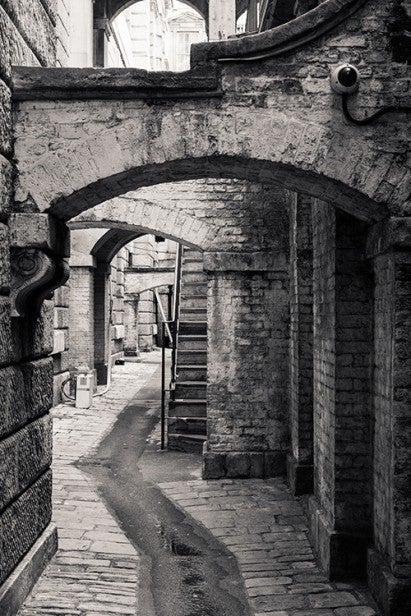
Distortion is exceptionally low, so straight lines stay straight
Out-of-focus backgrounds are usually rendered smoothly, although bright highlights tend to come out somewhat hard-edged, and become increasingly oval as you move off-centre.
Overall, the FE 50mm f/1.8 is capable of giving some very nice-looking images. More modern designs such as the Sony FE Planar T* 50mm f/1.4 ZA that we reviewed recently (AP 20 August) can certainly give even better results, but at a very much higher price.
Sony FE 50mm f/1.8 – Sharpness, shading and distortion
Sharpness: There’s not much to complain about in terms of sharpness, with the lens delivering pretty good results wide open. It improves progressively as it’s stopped down, with the very sharpest images obtained around f/5.6-f/11. The corners are measurably softer than the centre at all apertures up to f/8, but thanks to the aspheric element, they are better than what we would expect from a 50mm f/1.8 at large apertures.
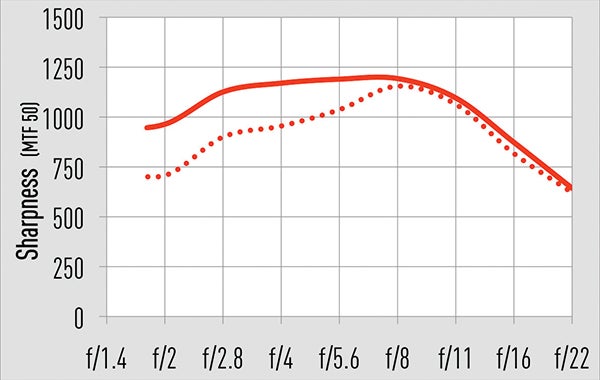 Solid line: Centre Dotted line: Corner
Solid line: Centre Dotted line: Corner
Solid line: Centre
Dotted line: Corner
Shading: As usual for this kind of lens, vignetting is quite obvious at large apertures, with a maximum of 1.5 stops fall-off at the corners of the frame at f/1.8. But it reduces quickly on stopping down, dropping to a barely noticeable 0.6 stops at f/2.8 and disappearing entirely by f/4.
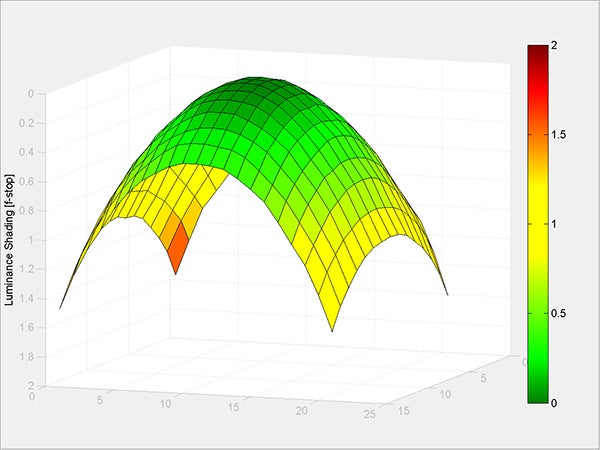
f/1.8
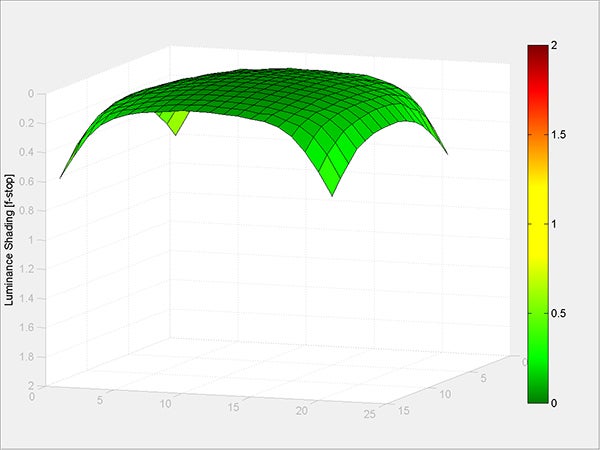
f/2.8
Distortion
Typically for a 50mm prime, distortion is exceptionally low. Unlike with many CSC lenses this near-perfect correction is entirely optical and doesn’t rely on any software compensation. In concert with the lens’s normal focal length, this results in subjects being drawn in a very natural-looking fashion.
Should I buy the Sony FE 50mm f/1.8?
It’s easy to understand what Sony has done with this FE 50mm f/1.8 lens. By giving it a tried-and-tested double Gauss design, the lens can deliver a very decent image quality, meaning the company is spared the need to expend resources developing a new optical formula. The result is a lens costing a lot less than Sony’s existing Sonnar T* FE 55mm f/1.8 ZA lens. But this approach comes with drawbacks, too – most notably, the painfully slow autofocus.
This is a shame, as it makes the lens difficult to recommend wholeheartedly. It’s OK if you mainly take your time over shooting static subjects, but this kind of fast prime is well suited to genres where fast focusing is desirable, such as environmental portraiture and street photography. For these, the 55mm f/1.8 would be a better choice. However, users on a budget who can tolerate the AF are unlikely to be disappointed by the image quality.
Verdict
Great image quality from a wide-aperture standard prime lens, but the autofocus speed lets it down.
The post Sony FE 50mm f/1.8 Review appeared first on Trusted Reviews.
Author: Andy Westlake
This article comes from Trusted Reviews and can be read on the original site.
